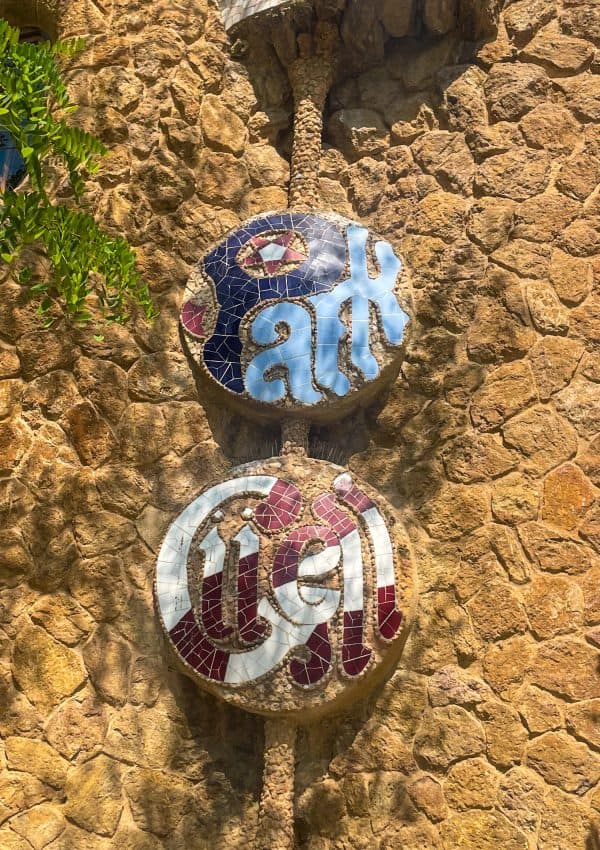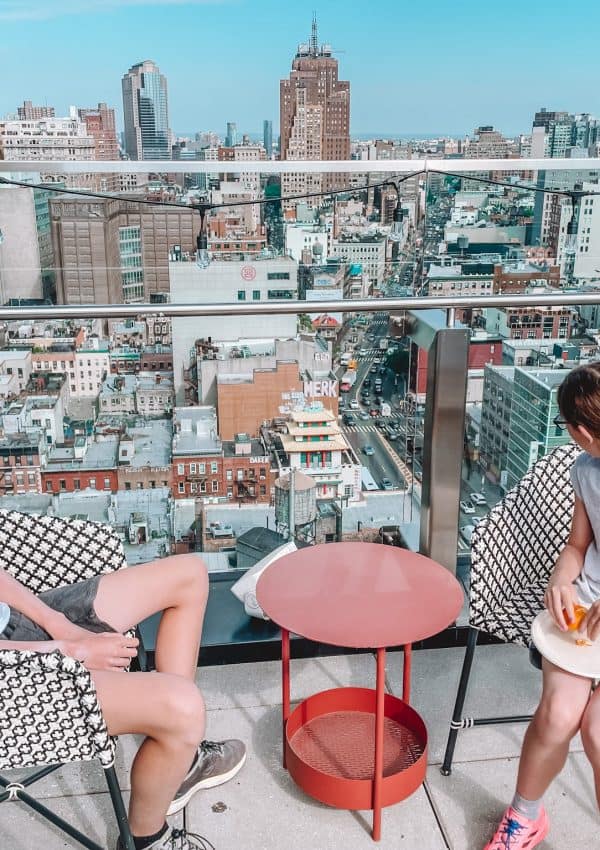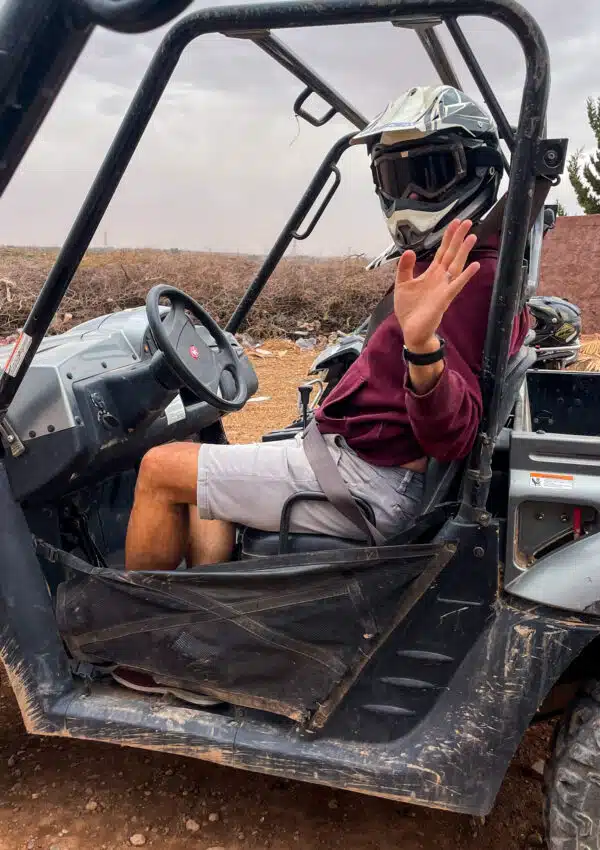Last updated on November 4th, 2024 at 07:13 pm

In the heart of Southeast Asia, the island of Borneo calls to travellers with its promise of lush rainforests, adventure, and some of the best wildlife spotting opportunities in the world. Borneo has become a bucket-list destination. But what is the best time to visit Borneo?
Whether you’re a family seeking those wildlife experiences which will make memories for a lifetime, want to find out more about Borneo’s diverse cultures, or a sunseeker looking for beautiful beaches, we’ll suggest the best time to visit Borneo for what you want to do.
Want the quick answer to the question: What is the Best Time to Visit Borneo?
We’d suggest that the best month to visit Borneo is April (perfect timing for the Easter holidays). This is when we visited and it was generally good weather-wise! If you can’t visit in April, then March, May and September are also good. These months have the least rainfall and temperatures aren’t quite as high as they are in the summer months. May and September may also be a bit cheaper and less competitive when it comes to securing accomodation.
The Best Time to Visit Borneo: Climate Overview
Borneo has a tropical climate with distinct wet and dry seasons.
Borneo’s tropical climate means that it’s hot and humid all year round, and that there’s regular rainfall, particularly in the rainy season. Have a look at the chart below to check average rainfall and temperature each month.
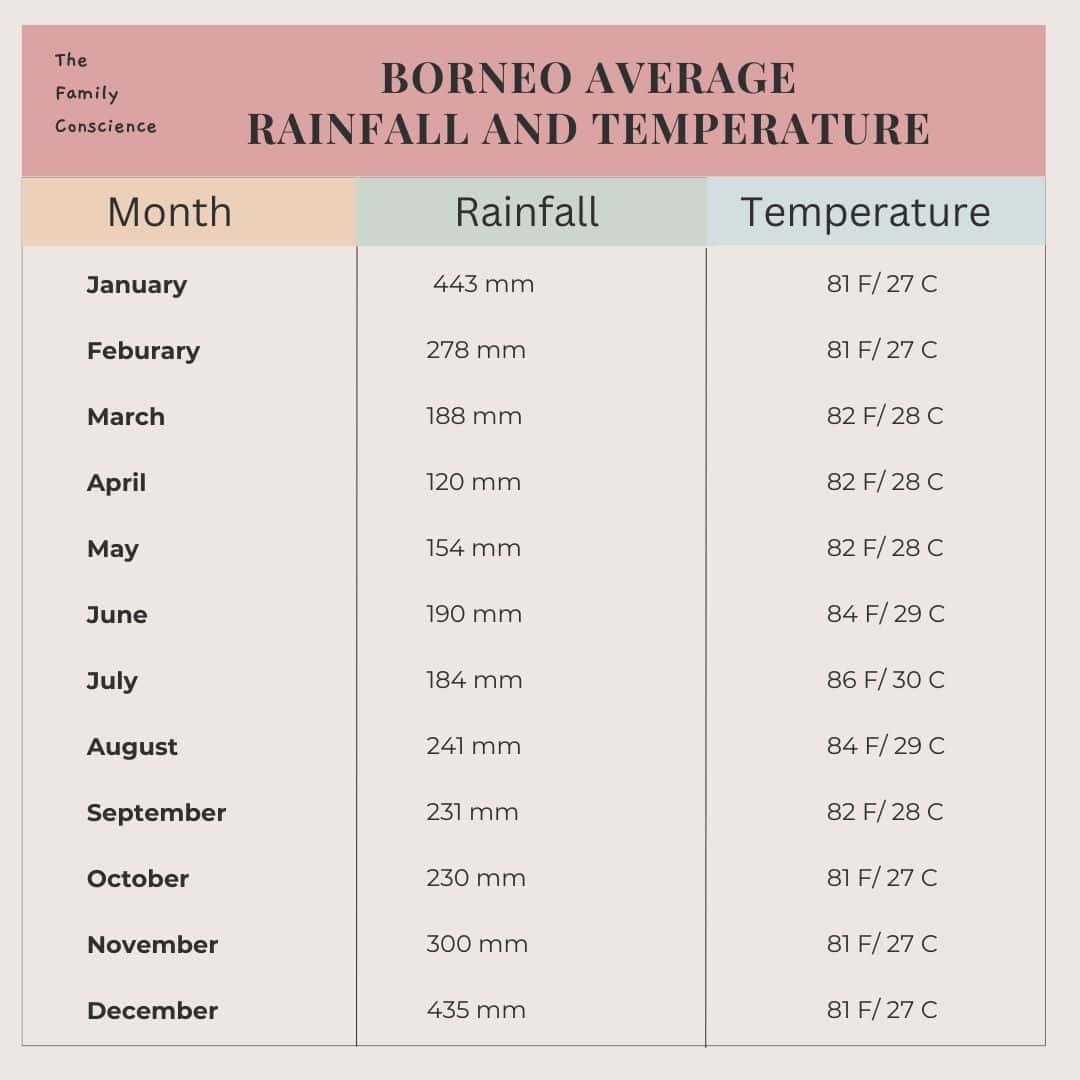
Borneo’s Wet Season
The wet season in Borneo usually begins in November and continues until March. There will tend to be variations depending on the specific region you’re visiting.
Borneo receives a substantial amount of rainfall during the wet season (particularly during December and January), which is what makes the island so lush and green. You can expect regular tropical downpours during the rainy season – often in the late afternoon or evening.
During the rainy season, you’ll find that there are also high humidity levels. It’ll feel pretty warm and sticky.
Pros and Cons of Visiting in Borneo’s Rainy Season:
Pros:
- The wet season brings Borneo’s rainforests to life, creating spectacular displays of flowers and plants and lush green landscapes.
- Rainy season offers the best opportunities to witness waterfalls and other water sources in their full glory.
- The wet season is an excellent time for birdwatching, as many species become more active.
- Certain wildlife, such as insects and amphibians, will be much more visible in the wet season.
- It’s low season, so there won’t be as many tourists during rainy season. This is the best time of year to visit Borneo if you want to have more of Borneo to yourself!
Cons:
- Certain areas, especially those with challenging terrain, might be less accessible. Hiking trails, for example, may not be as easy to access. You may need to change your plans if the weather is particularly bad.
- You should be prepared for sudden rain showers and you’ll need to ensure you bring appropriate rain gear with you.
- Rainfall can be significant during the wet season and can occasionally lead to flooding in low-lying areas.
Borneo’s Dry Season
Borneo’s dry season typically spans from April to October, although as is the case with the wet season, the weather will vary depending on where you’re staying.
During the dry season, you’ll experience lower humidity levels than in the wet season. Temperatures tend to be a bit milder as well.
As the name of the season suggests, there’s a lot less rain at this time of year and the weather tends to be more predictable – which is great in terms of planning your activities.
Pros and Cons of Visiting in Borneo’s Dry Season:
Pros:
- The dry season is the best time to travel to Borneo if you’re planning on prioritising outdoor adventures such as trekking, hiking, or heading to the beach – and you’re unlikely to have the constant threat of rain impacting on your plans.
- Wildlife can be more active during the dry season, and it’s an excellent time to see animals such as orangutans and proboscis monkeys.
- Humidity levels are lower, which will provide you with more comfortable conditions in which to explore.
- The dry season is ideal for enjoying the beaches of Borneo and for water activities like snorkelling and diving, due to clearer waters and calmer seas.
- There are more festivals and events which take place during the dry season which will give you the chance to experience local traditions and way of life.
Cons:
- Due to the optimal weather, the dry season is peak tourist period. You’ll definitely need to book accommodation and activities in advance. Some activities may be booked out.
- As it’s peak tourist season and demand is higher, prices often follow suit.
- With limited rain and cloud cover, you’re more likely to be affected by the sun and heat. Remember to keep hydrated and wear sunscreen.
Best Time To Go To Borneo To See Orangutans
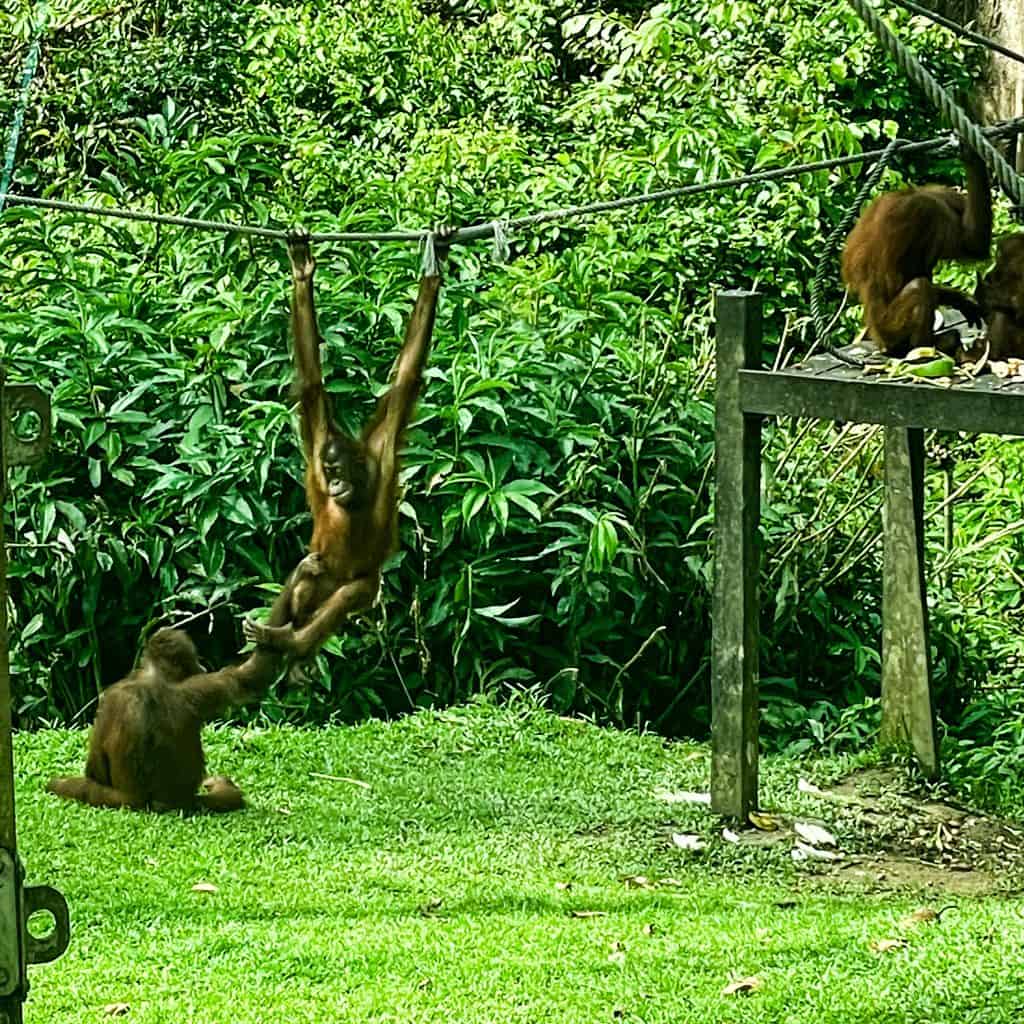
Generally, the dry season (April to October) is considered the best time of year to see orangutans. Weather conditions are more predictable, making trekking and outdoor activities easier to plan.
During the dry season, orangutans will also tend to be more active and visible, so you’ll be more likely to see them in their natural habitat.
Within the dry season, the months of June to September are often considered the best time to go to Borneo to see orangutans. Vegetation is less dense during this time, which makes it easier to see orangutans in the rainforests.
Of course, the flipside of visiting Borneo to see Orangutans in dry season is that rehabilitation centres and national parks tend to receive a higher number of visitors during these months. So, you will be competing with others to see wildlife. You might not be able to get as close, plus animals might be more cautious and stay away when there are large groups of people nearby.
The Best Places to See Orangutans in Borneo
We visited the renowned Sepilok Orangutan Rehabilitation Centre in Sabah. It’s popular year-round, but busiest in the dry season.
Sepilok Orangutan Rehabilitation Centre puts food out for the wild orangutans, giving a greater chance of you being able to see them. They also have an orangutan nursery for orphaned infant orangutans in need of rehabilitation. You can watch the young orangutans play from the observation centre.
Some of the other best places to see orangutans in Borneo include:
- Danum Valley Conservation area in Sabah, Malaysian Borneo. This conservation area is well known for its bio-diversity.
- Tanjung Puting National Park in Central Kalimantan, Indonesian Borneo. There are several rehabilitation centres here including Camp Leakey.
- Kinabatangan River in Sabah, Malaysian Borneo. We loved our stay in a lodge by the edge of the river. Ours, as well as others, had guided wildlife excursions along the river every morning and evening included in our stay. We saw so much wildlife during this part of our trip. While we didn’t see any orangutans while we were here, we did hear one above our lodge in the middle of the night.
Obviously, orangutans are wild animals, and sightings can’t ever be guaranteed.
Whatever season you visit in, make sure the wildlife conservation centres you visit are ethical and responsible. Orangutans are an endangered species (due to deforestation and habitat loss, illegal hunting and the pet trade) so it’s important to support orangutan conservation efforts and ensure the well-being of these incredible creatures.
The places suggested above are all comitted to conservation work for orangutans.
NOTE: Of course, when it comes to wildlife, it’s not just orangutans you can expect to see in Borneo. Head to What Are The Borneo Big 5? for more information on Borneo’s incredible endemic animals.
Borneo’s Festivals and Events Throughout the Year
Borneo has a number of festivals and events throughout the year. These are a great opportunity to catch a glimpse of life in Borneo. If you’re interested in learning more about Bornean culture, you might want to combine your trip with a visit to one of these festivals and events in Borneo:
Gawai Dayak (1st – 2nd May):
Celebrated by the Dayak people in Sarawak, Malaysia, Gawai Dayak is a festival which marks the end of the rice harvesting season. There’s usually music and dance, ceremonies and traditional food on offer.
Pesta Kaamatan (May):
Pesta Kaamatan is another harvest festival, celebrated by the Kadazandusun people in Sabah, Malaysia. You might have the chance to observe performances, traditional sports, and the crowning of the Unduk Ngadau (Harvest Festival Queen).
Borneo Jazz Festival (May/June):
Located in Miri, Sarawak, the Borneo Jazz Festival attracts jazz enthusiasts from around the world. The festival features local and international jazz performers – perfect for music lovers.
Pesta Kaamatan is another Harvest Festival, celebrated by the Kadazandusun people in Sabah, Malaysia. You might be able to observe performances, traditional sports, and the crowning of the Unduk Ngadau (Harvest Festival Queen).
Rainforest World Music Festival (July/August):
Held in Sarawak Cultural Village, the Rainforest World Music Festival is a three-day event featuring well-known musicians performing a range of traditional and fusion music.
Borneo Cultural Festival (July):
Held in Sibu, Sarawak, this festival celebrates the diverse cultures of Borneo with traditional dance, music, and performances. The event aims to preserve and promote the unique heritage of this region.
Bon Odori Festival (July/August):
Celebrated in various locations in Sabah, particularly in Kota Kinabalu, the Bon Odori Festival is a Japanese Buddhist event that’s become popular in this area. You’ll get a chance to see traditional Japanese dance and taiko drum performances, as well as soaking up the carnival-like atmosphere.
Borneo International Kite Festival (August):
Held in Bintulu, Sarawak, the kite festival attracts kite enthusiasts from around the world. As well as kite displays, you can take part in kite-making workshops and competitions.
Tabalong Festival (September):
Celebrated in Kalimantan, Indonesia, the Tabalong Festival celebrates the traditional cultures of the Dayak people through performance.
Remember to check local calendars and event listings for the most up-to-date information on Borneo’s festivals and events.
Beaches in Borneo and Diving

Not many people think of Borneo as a beach destination, but it’s home to some stunning beaches with pristine white sands, crystal-clear waters perfect for snorkelling and lush jungle surroundings.
When to visit Borneo if you’re a beach-lover? Dry season is the best time to head to Borneo’s beaches. When it comes to diving, April to December is often considered best as the underwater visibility is better and the sea calmer.
Here are some of the best beaches in Borneo:
Pantai Tanjung Aru (Tanjung Aru Beach), Kota Kinabalu (Sabah, Malaysia):
The closest beach to Kota Kinabalu, Tanjung Aru Beach offers breathtaking sunset views. It’s a popular spot for locals and visitors alike, with picturesque views of nearby islands. You won’t tend to find many people swimming here but it’s a sociable and lively place to hang out.
Tunku Abdul Rahman National Park
A number of islands make up Tunku Abdul Rahman National Park and you’ll find some of the best beaches in Borneo in this area. Gaya Island Resort (a 15-minute speed boat ride from Kota Kinabalu) is particularly impressive -they have their own marine centre and some of the best snorkelling in Borneo.
Damai Beach, Kuching (Sarawak, Malaysia):
Located near Kuching, peaceful Damai Beach is surrounded by rainforest and is good for swimming. It’s also close to Sarawak Cultural Village and Mount Santubong – both worth a visit.
Pantai Dalit Beach, Tuaran (Sabah, Malaysia):
This beach is located within the Shangri-La’s Rasa Ria Resort – one of the places we stayed at while we were in Borneo. It’s a lovely beach but we didn’t actually swim here. The currents are quite strong and the tide goes out pretty far. Rasa Ria has a nature reserve and discovery centre attached to it – so it’s a great place to stay if you want a balance of beach and nature.
Sipadan-Kapalai Dive Resort Beach (Sabah, Malaysia):
While primarily known as a diving destination, the beach surrounding the Sipadan-Kapalai Dive Resort has lovely white sandy shores and clear turquoise waters.
Mabul Island Beach (Sabah, Malaysia):
Mabul Island is close to some popular Borneo diving spots, but it’s also home to one of the best beaches of Borneo.
Pulau Tiga (Survivor Island), Sabah (Malaysia):
Famous for being the location of the first season of the reality TV show Survivor, Pulau Tiga offers secluded beaches, clear waters, and the opportunity to explore its active mud volcanoes. It’s probably a day trip to visit – you’ll need to travel two hours south of Kota Kinabalu to Kuala Penyu, then it’s a 30-minute speedboat to the island.
Travel Tips for Borneo’s Rainy Season (November to March)
- Pack waterproof clothing, including a rain jacket, poncho, and suitable footwear. Quick-drying clothes can be a great idea if you’re travelling during the wet season.
- Due to increased humidity, bring mosquito repellent to protect against potential mosquito bites. Mosquitos love hot temperatures and high humidity.
- Think about purchasing waterproof or water-resistant luggage to protect your belongings from the rain.
- Keep your itinerary flexible, as heavy rainfall may affect any outdoor activities you plan. Check the weather forecast and have an indoor or rain-friendly activity identified as a back-up option.
- Despite the rain, the wet season can be an excellent time for wildlife watching. Some species, especially birds, are more active during this period. So, bring your binoculars!
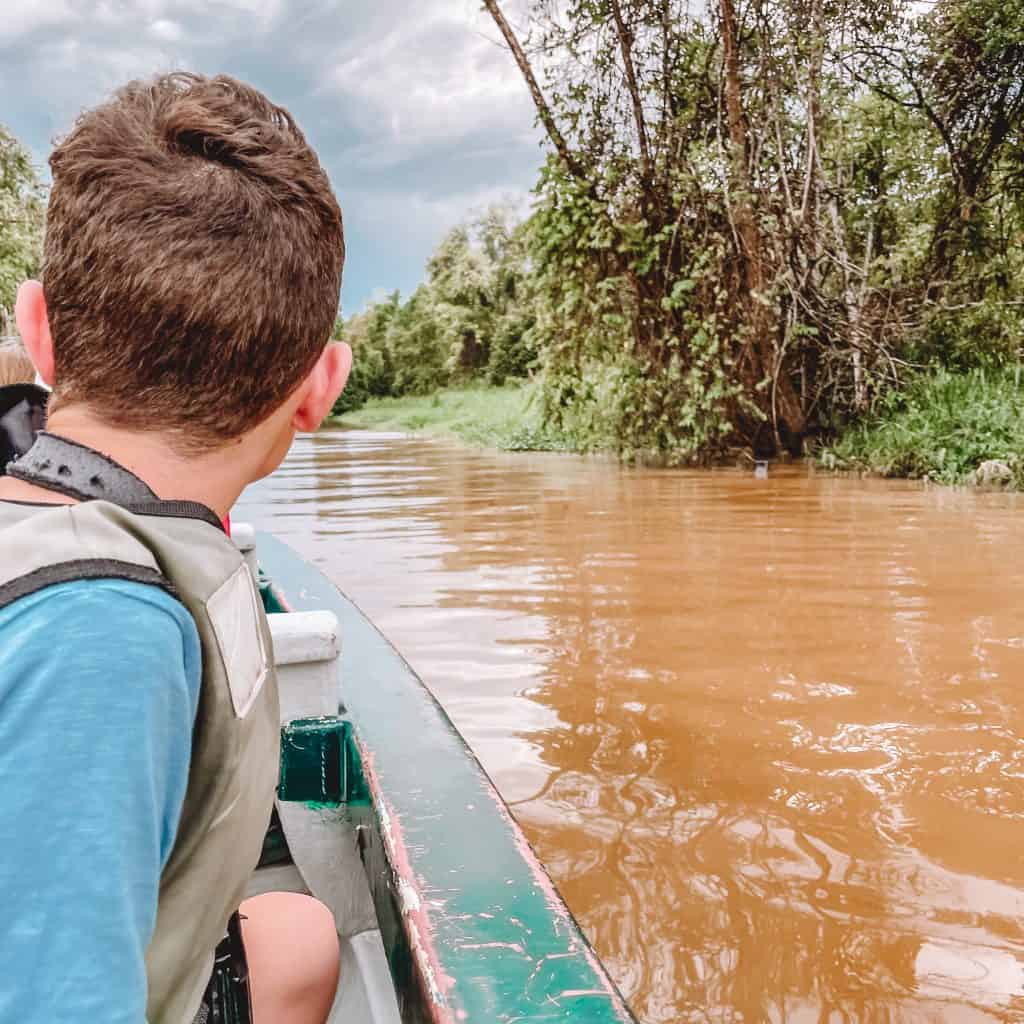
Travel Tips for Borneo’s Dry Season (April to October):
- Pack lightweight, breathable clothing to stay comfortable in the warm and dry weather. Don’t forget a hat and sunglasses for sun protection too.
- Stay well-hydrated, as temperatures can be high during the dry season. Carry a reusable water bottle and drink plenty of fluids.
- Use a sunscreen with high SPF to protect your skin from the sun. Remember to reapply it if you’ve been snorkelling or swimming.
- Take advantage of the dry weather and plan lots of outdoor activities such as trekking, hiking, and water sports. Many wildlife species are more active during this season too.
- Check the calendar for festivals and events (like the ones listed above) happening during the dry season. It’s a great time to immerse yourself in the local culture.
- Accommodation is in demand during the dry season and gets booked up quickly. Consider booking in advance, especially for popular destinations.
Borneo Best Time To Visit: The Verdict
Borneo will take your breath away no matter when you visit. There’ll be multiple opportunities to see amazing wildlife and explore beautiful rainforest landscapes.
However, there’s definitely a ‘best time of year to visit Borneo’ and that is the months of April and May, followed by March and June. This is the beginning of the dry season when the rainforest will look wonderfully lush and temperatures haven’t got as high as they will do in the summer months.
Take a look at our post Borneo With Kids and the Perfect Family Itinerary to plan your trip during Borneo’s dry season.
December and January bring significant rain, so I would think twice about a trip to Borneo during these months. A trip in the summer months (June, July and August) is a reasonable option if Spring doesn’t work for you.
Bear in mind that it will be busier in the dry season – you’ll have to book accomodation ahead of time, and your activities too.

